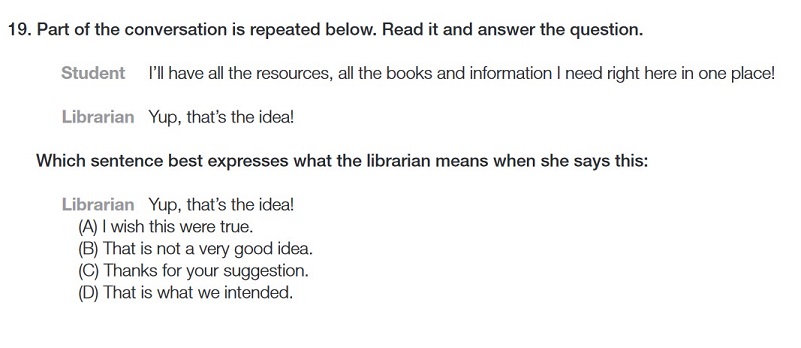
At first glance, TOEFL Listening may seem like an easy section: all you have to do is pay attention to some short conversations and answer a few questions on them. Should be easy for anyone who has watched a movie or listened to music in English, right? As a matter of fact, the TOEFL Listening section is often challenging because it requires test takers to remember facts and information from several-minute long recordings and then answer questions on specific information mentioned in the recording.
To really ace the TOEFL Listening test, you need to know exactly what types of questions you’ll be seeing, how you should be studying, and how to take great notes on test day. We cover all those topics and more helpful TOEFL Listening tips in this guide.
TOEFL Listening Section Overview
Listening is the second of four sections on the TOEFL. The entire section lasts 60 to 90 minutes and includes four to six lectures and two to three conversations. Each lecture lasts about three to five minutes and is followed by six questions, and each conversation lasts about three minutes and is followed by five questions.
The variation in time and length is due to the fact that some test takers will have un-scored experimental questions in their TOEFL Listening section, making it extra long, while others will have experimental questions during their Reading instead. You won’t know which questions are experimental and which are graded, so try not to worry about it too much.
The lectures and conversations will be similar to those you’ll likely hear as a student. They may be a conversation between a student and teacher, a class discussion, a lecture by a professor, or a similar scenario. There will be pictures on the computer screen to give you an idea of how many people will be speaking and what the setting will be.
For some questions clips of the conversation or lecture will be replayed, but other than that, you’ll only hear the audio clip once. You don’t have the option to replay it. This section tests your ability to understand spoken English, listen for pragmatic understanding, and connect and synthesize information.
By the way: we have built the world's best online TOEFL course. Get online practice (TPO-sytle!) and individual grading and feedback on Speaking and Writing.
To be fair, it's possible to get a good TOEFL score studying alone. But PrepScholar is the world's most effective TOEFL course if you are worried about the TOEFL and are struggling to improve your score.
Learn how you can improve your TOEFL score by 15 points today.
What Types of Questions Are There on TOEFL Listening?
You will come across three types of questions as you complete the TOEFL Listening test. Since it’s important to know what to expect, in this section we explain the different types of question and, for each question type, give a sample question and tips to help you answer those types of questions.
Standard Multiple Choice
You likely have a lot of experience with these types of questions. For each question there are four answer choices, only one of which is correct. You’ll need to choose the correct one. This is the most common question type you’ll see in TOEFL Listening.
Sample Question

Tips for Answering
- Read every answer choice. This may seem like obvious advice, but on the day of the test it’s easy to see an option that looks pretty good, choose it, and move along to the next question without checking to make sure there isn’t a better option. ETS will try to make some answer choices sound like the right answer, when they’re actually not. Reading through all your options will help you avoid getting fooled.
- Take notes while listening to the audio recording (how to do this is discussed in more detail below). Make them short and clear so you can easily review them when answering questions. They’ll often help you remember points you may have forgotten and that will help you answer questions correctly.
Multiple-Answer Questions
These questions are like the standard multiple-choice questions except they can have more than one correct answer. You’ll need to get all the answer options correct in order to receive credit for these questions.
Sample Question

Tips for Answering
- Questions with more than one answer will also be labeled as such, and you’ll also be told how many correct answers there are, so be sure to pay close attention when answering these questions so you don’t miss important information.
- For these questions especially, make sure you read through each answer choice to be sure you don’t miss a correct answer. You don’t get partial credit for these questions, so you’ll need to select every correct answer choice in order to get the question right.
“Replay” Questions
For these questions, you’ll hear a short part of the clip played again, and you’ll then be asked a question on that specific portion of the clip. They then follow the format of standard multiple-choice questions. This is the only time on the Listening section where you’ll get to listen to part of the audio recording again.
Sample Question

Tips for Answering
- Even if you took good notes during while listening to the complete audio recording, play close attention when the short clip is replayed. You’ll often be asked about a specific detail from the clip that you wouldn’t remember just by looking at your notes.
- Focus primarily on the clip that was replayed as opposed to what was said in the rest of the recording. For almost all these types of questions, you’ll be able to choose the correct answer based just on the clip, so you don’t need to worry about remembering what happened in the rest of the recording.

TOEFL Listening Tips for Studying
Now that you are up-to-date on what to expect on the TOEFL Listening test, read these four tips and follow them throughout your studying in order to be prepared on test day.
Listen to Spoken English Regularly
The number one TOEFL Listening tip is, unsurprisingly, to listen to English regularly. The more you hear English, the better your listening skills will become and the easier you’ll find the Listening section. You want to listen to spoken English, so music sung in English won’t be as useful since English sounds different when it’s sung compared to when it’s spoken.
Talk radio, news stations, movies, tv shows, and podcasts are all great options (as long as they’re in English, obviously). Try to listen to some English with background noise, such as an interview conducted outside or in front of a large crowd. TOEFL Listening recordings purposely include background noises, so you’ll want to be used to that.
Listen to Different English Accents
It will also help you down the line if you practice listening to different accents while you’re studying. The TOEFL Listening test will include at least one native-speaker English accent outside of North American accents. This is done to help prepare you for the variety of English accents you’ll likely come across in the real world. These accents will come from the U.K., Australia, or New Zealand.
Even native English speakers can struggle to understand different English accents, so be sure to get some exposure to different accents before exam day. Try listening to news clips or radio stations from these countries if you’re wondering how you can hear more accents.
Take Complete Practice TOEFL Listening Tests
Part of what makes TOEFL Listening tricky is that you spend the section going back and forth between listening to recordings and answering questions on them. After three or four recordings, you may get tired and your attention may start to lag. This can really hurt your score if you miss important information in the audio recording, so you want to take steps to avoid this, and one of the best ways to do that is to take complete practice Listening sections.
A full Listening section is four lectures and two conversations. Set aside time to take this section all at once, with no breaks and no distractions, just like on the real TOEFL. Doing this will help you become familiar with the length and pacing of the Listening section before test day.
If you need tips on where to find practice resources, check out our guide to the best TOEFL Listening study materials.
Get in the Habit of Taking Notes
Even if you have great English skills and usually remember the things you hear in English, you should still takes notes during the Listening section. Each of the recordings is several minutes long and contains a lot of information. If you don’t take notes, it can be easy to forget some of points made and therefore miss questions on the test. Read the next section for tips on how to take great notes.

How to Take Great TOEFL Listening Notes
The notes you take on TOEFL Listening will often be key to how high a score you get on this section. It’s important that they are clear and contain the information you’ll be tested on. Below are the three tips you should follow to take great Listening notes.
Want to improve your TOEFL score? We have the world's leading TOEFL course.
Built by world-class instructors from Harvard and MIT, the course offers individual review, interactive lessons, and realistic online praactice, at an affordable price! It's the fastest way to get your target TOEFL score.Stay Focused While the Recordings Are Playing
The TOEFL is a long exam, and it can be easy for your mind to wander during parts of it. However, one of the worst times for this to happen is during the Listening section when the audio recordings are playing. You only get to hear each recording once, so if you miss a key point, you likely won’t have all the information you need to get a top score on this section. Your notes will only be great if you do a great job listening to the recordings, so make it a priority to pay attention while they’re playing.
The longest each recording will be is five minutes, so work to keep your focus for that long (doing practice problems, as discussed above, will help you with this). The part of the Listening section where you’re answering questions is typically less rushed than other sections (you’ll have about 35 seconds to answer each question), so, if you need to take a mental break for a few seconds, do it then so you can be ready to focus on the next recording when it starts playing.
Write While Listening
Some TOEFL test-takers try to listen intently while the audio recording is playing and only begin writing notes once it’s finished. This is a bad idea for two reasons. First, the audio recordings are each several minutes long, so you’ll likely forget some key points when you’re trying to write all your notes at once. Second, not writing your notes until after the recording has ended means you’ll be writing them during your time to answer questions, which can make you more rushed during the answer portion of the section.
Instead, write notes throughout the recording. Keep them short (see below), and try to work out a pattern where you listen for a brief period of time, write down some short notes, then go back to listening. Practicing will help you get better at this.
Focus on Main Ideas
Don’t try to write down everything you hear. You won’t be able to, and you’ll likely miss some important points because you’re trying to copy every word. Instead, focus on the main ideas in the recording.
If you’re listening to a lecture, think about (and take notes on) what the professor is trying to accomplish. Is he/she trying to explain a new topic? Make something clearer? Explain two different opinions? If another person, such as a student speaks, what are they trying to learn or show? You may want to make a column in your notes for each speaker and write the main points of what they say under the appropriate column to make it easier to remember who said what.
It can be easy to get bogged down in all the details of a recording and miss out on what’s really being discussed. The majority of TOEFL Listening questions will focus on major points as opposed to minor details, so focus your notes on the former.
Review: How to Do Well on TOEFL Listening
You’ll need strong listening skills, as well as good concentration skills, in order to ace the TOEFL Listening test. Besides knowing what types of recordings and questions to expect on this section, you’ll need to do some studying as well.
The most important TOEFL Listening tips for studying include listening to spoken English regularly, listening to different English accents, take complete practice TOEFL Listening tests, and get in the habit of taking notes. During the TOEFL Listening, you should stay focused when the recordings are being played, write while listening, and focus on main ideas when taking notes.
What’s Next?
Not sure what TOEFL score you should be aiming for? Learn what a good TOEFL score is based on the schools you’re interested in.
Want more tips on how to prepare for TOEFL Listening questions? Check out our guide to the best ways to practice for TOEFL Listening!
Ready to do a full-length practice test on TOEFL Listening? Check out PrepScholar’s Listening Practice Test on YouTube!
Once you’ve taken the TOEFL, how do you send your scores to schools? Learn the six tips you need to know for sending your TOEFL Scores.
Ready to improve your TOEFL score by 15 points?
Download our best TOEFL Strategy eBook (valued at $14.49) for FREE! Learn the top 5 strategies you must know to improve your TOEFL score. Download it for free now:

Comments are closed.